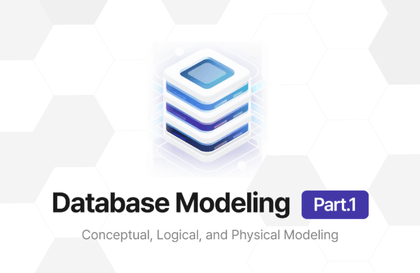
金英漢の実戦データベース - 設計1編、現代的データモデリング完全攻略
yh
データベース設計を概念的、論理的、物理的の3段階で体系的に学び、実務中心のショッピングモールプロジェクトで能力を強化します。現代的な設計技法と最新トレンドを通じて実戦ノウハウを身につけます。
초급
SQL, MySQL, DBMS/RDBMS
You can understand and master all the web technologies required for web application development from the basics. In Part 2 of MVC, you can learn all the utilization technologies required for practical web development on top of the core principles and structure of Part 1 of MVC.
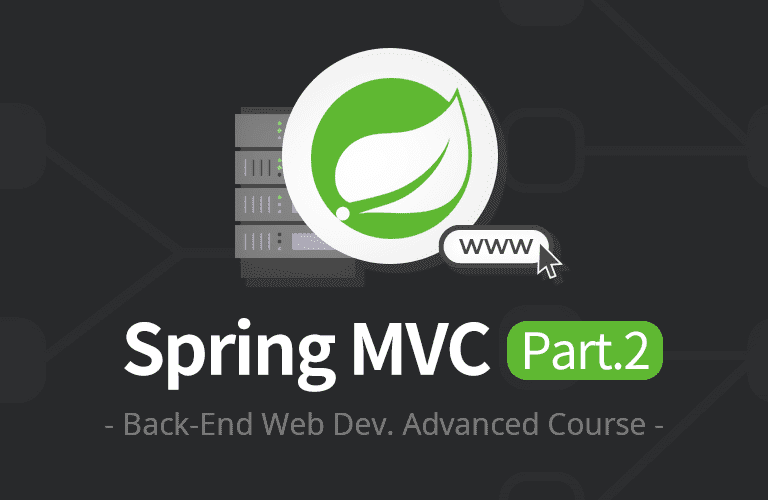
Java Backend Web Technologies
Spring Web Technology
Spring MVC
If you know the principle, you will see the core!
Kim Young-han's Spring MVC Utilization Guide 👨💻
📌 Please check before taking the class!
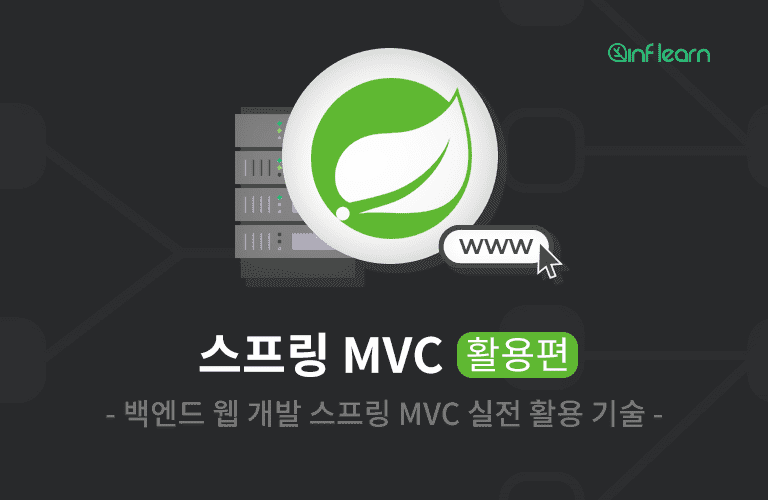
Most modern applications are web applications that operate in a web environment. Java backend developers often use Spring MVC when developing these web applications. Spring MVC is the most popular web framework, facilitating the rapid and easy development of complex web applications.

Java backend web technologies are vast and require extensive study. Spring MVC, in particular, offers extensive functionality and a complex architecture. To truly master these web technologies, you must first understand the core principles and structure of Spring MVC, then build on that foundation to master a vast array of web-based technologies one by one.
Please check whether you understood the core principles and structure of Spring MVC required for web development through the previous lecture, <Spring MVC Part 1> .
1. From the beginning of Java web technology to the latest practical technology
2. Developing the MVC framework directly in code
So far, we've been learning about Java backend and Spring MVC-based technologies. In this lecture, we'll build on what we've learned so far and learn essential practical skills .
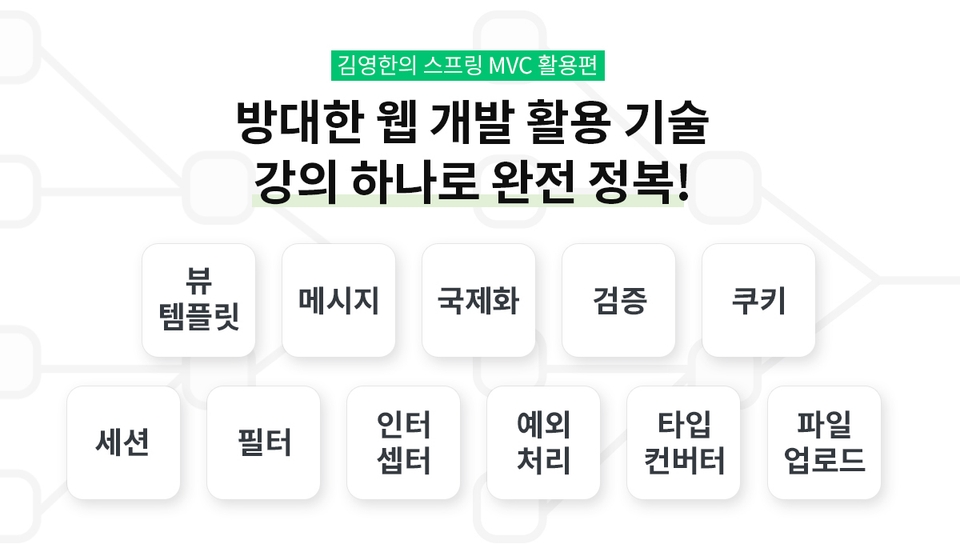
In Part 2 of Spring MVC, you can completely conquer a vast range of web utilization technologies such as view templates , messages , internationalization , validation , cookies , sessions , filters , interceptors , exception handling , type converters , and file uploads , which are essential for practical use, through examples, based on the Spring MVC learned in Part 1.
We will help you develop a wide range of web utilization technologies through practical example code on top of Spring MVC and its core principles and structures, and help you grow into a more in-depth backend web developer .

Spring MVC
First-time developer

backend developer
job seekers

Spring MVC in depth
Developers in the field who want to understand

Web App with Spring
Developers who want to create
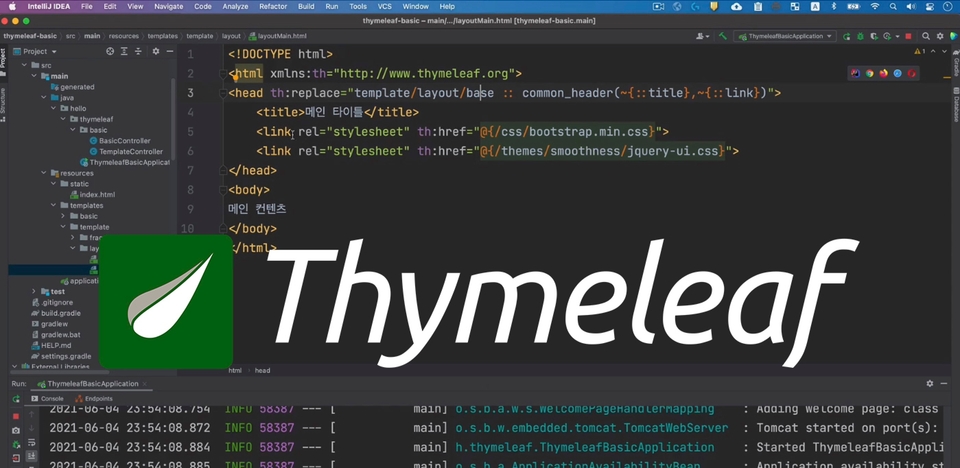
Thymeleaf is a server-side view template for backend developers. With Thymeleaf, backend developers can quickly and easily create dynamic HTML without the need for a separate frontend developer.
In this course, you will learn everything from the basic functions of Thymeleaf to integration with Spring and complex form management features such as check boxes, radio buttons, and select boxes, all through examples.

As web applications grow larger and more complex, the various messages they use must be managed consistently and in a single location. For example, changing the word "product name" to "product name" requires editing the source code of numerous files. Spring's messaging functionality allows you to manage and modify these messages in one place.
Internationalization refers to the ability for a website to appear in English for English speakers and in Korean for Korean speakers. Spring already provides this internationalization functionality. In this lecture, we will learn about Spring's messaging and internationalization features step-by-step through real-world examples.
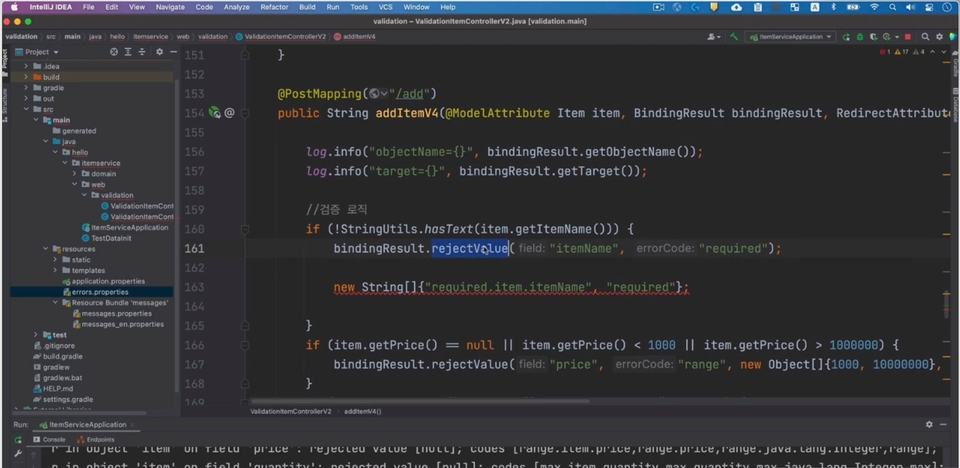
If a customer enters incorrect values in a form during membership registration and submits them to the server, the server must verify those values, re-present the form to the customer, and provide helpful guidance on what was entered incorrectly. This is a necessary feature for all web services.
In this lecture, we'll first develop these validation functions ourselves. We'll also use Spring's validation features, and we'll go further and learn step-by-step through examples, including Bean Validation, which conveniently performs validation with a single annotation.
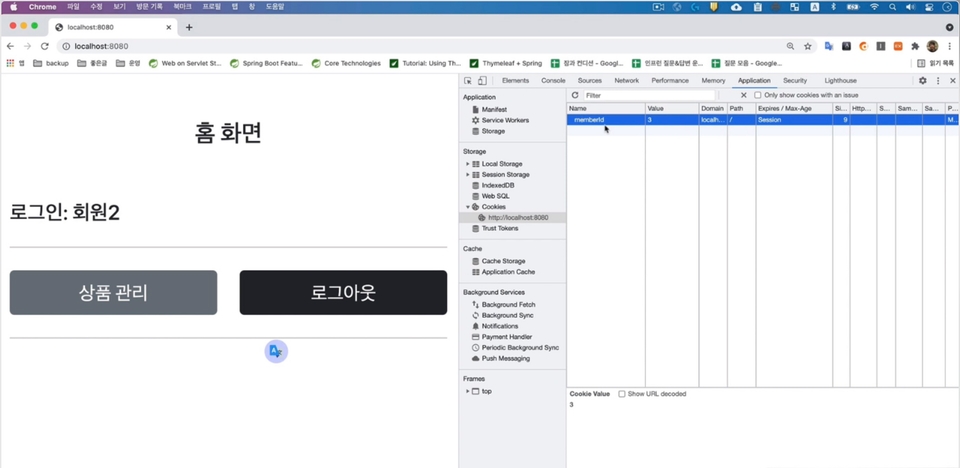
HTTP is a stateless protocol. Therefore, concepts like cookies and sessions are necessary to maintain login functionality. In this lecture, we'll first create a login function using only cookies. We'll then examine security vulnerabilities and then create and implement sessions.
By creating sessions directly like this, you'll gain a deeper understanding of how cookies and sessions work. Additionally, you'll learn about and apply sessions provided by servlets.
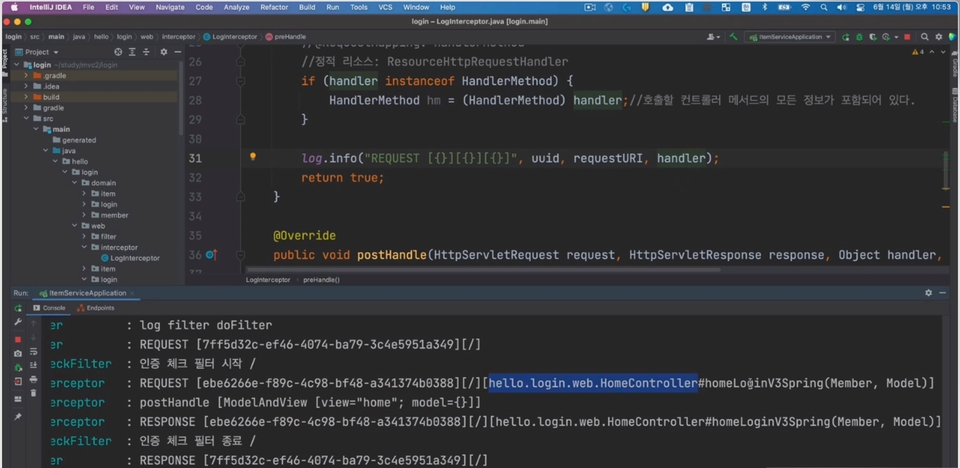
We will learn about the Filter provided by Servlet and the Interceptor provided by Spring through examples.
First, we'll create a filter and interceptor to log all HTTP requests, the simplest of which is to use filters and interceptors. Later, we'll also create a filter and interceptor for authentication processing. By using both together, we'll clearly understand the pros and cons of each.

When learning web applications, exception handling is often the most difficult part to understand. This is because the servlet container (WAS) and Spring MVC each provide their own exception handling methods. In reality, these two mechanisms are intertwined, resulting in a complex exception handling mechanism. Therefore, it's extremely difficult for developers to accurately understand and use the internal workings of Spring and the servlet container when an exception occurs in a controller.
This lecture will explain exception handling in a step-by-step manner, from servlet container exception handling to Spring MVC exception handling. After attending, you'll gain a clear understanding of how server internals work when an actual exception occurs and what changes need to be made. Additionally, exception handling when using the API will be covered.

Just as you need to convert characters to numbers or vice versa, developing applications often requires type conversion. For example, even if the string "10" is passed in an HTTP request, Spring can receive it as the integer 10 using @RequestParam . Spring provides a feature called type converters to support consistent type conversion.
Type converters are a frequently mentioned topic when learning Spring, but understanding how they actually work can be challenging. This lecture will provide a step-by-step understanding of type converters, from the basics to their practical application, through examples.
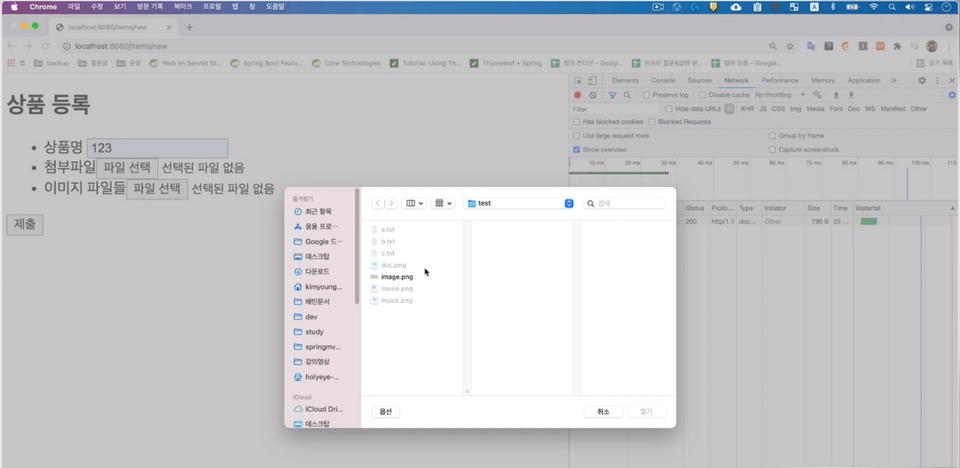
There are countless file upload examples available online. This lecture goes beyond simply explaining the file upload functionality. It delves into the protocols used for file uploads and explains the principles that make file uploads possible over HTTP. Furthermore, through examples, you'll learn the file upload functionality step-by-step, from servlets to convenient file upload methods provided by Spring.
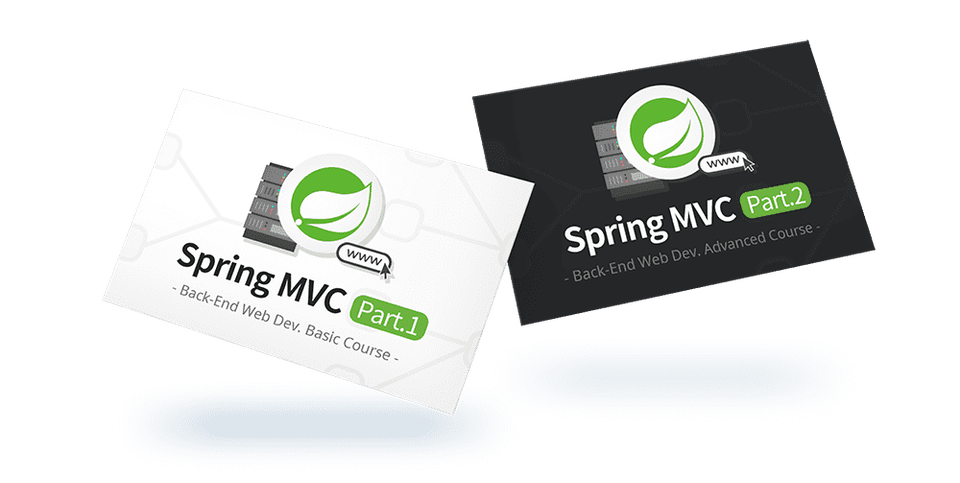
The Spring MVC lecture is divided into two parts.
This lecture is Spring MVC Part 2 -
It is a technology that utilizes backend web development .
Cover the core concepts of Java web technology and Spring MVC, and understand the basic features of Spring MVC.
Part 1 introduces Java backend web technologies, then covers the full spectrum of web technologies, including Servlets, JSP, the MVC pattern, and the MVC framework. After understanding the background of web technologies, we'll solidify a solid foundation in the core concepts of Spring MVC. We'll then explore the basic features of Spring MVC and develop a web page capable of basic CRUD operations using Spring MVC.
Learn various techniques for utilizing Spring MVC.
Part 2 gradually develops a single example, learning various Spring MVC utilization techniques through code, including Thymeleaf, messaging, internationalization, validation, cookies, sessions, filters, interceptors, exception handling, common features, and extension points.
We're preparing a series designed to help you master Spring completely. We'll focus on core Spring features used in real-world applications, boldly omitting obsolete or outdated features, and provide practical know-how.
Kim Young-han's Complete Spring Conquest Series
Spring Core Principles - Practical Applications This lecture includes:
Complete mastery of Spring Boot + JPA practices
Advanced Practical Training on the Latest Backend Technologies
Who is this course right for?
Developers new to Spring MVC
Developer job seeker
Working developers who want to deeply understand Spring MVC
Developers who want to create web applications with Spring
Need to know before starting?
Java language
Spring Basics
HTTP Basic Concepts
Spring MVC Part 1 - Core technologies for backend web development
559,467
Learners
36,767
Reviews
8,971
Answers
5.0
Rating
25
Courses
교육자
전: 우아한형제들 기술이사, 카카오, SK플래닛
진짜 실무에 필요한 제대로 된 개발자가 될 수 있도록, 교육하는 것이 저의 목표입니다.
EO 인터뷰 영상
개발바닥 - 시골 청년 개발왕 되다
All
129 lectures ∙ (21hr 5min)
Course Materials:
4. Create a project
06:33
8. Basic Objects
06:45
10. URL link
06:22
11. Literal
05:58
12. calculation
06:27
14. repeat
08:48
16. annotation
06:47
17. block
04:15
22. organize
11:34
All
1,168 reviews
5.0
1,168 reviews
Reviews 3
∙
Average Rating 5.0
5
息をする前に講義が出てすぐに疲れました。 mvc2編出る前に一度 チーム長 jpa ロードマップ まず頑張らなければならず、スプリングデータjpaしていました mybatis 書く jpa 俳優なので新世界だって ついにmvc2編講義が出て、ちょっと前の部分だけ見てjpaロードマップさえ終えてまたmv2編講義を聞かなければならないのにタイムリーフがとても面白くてずっと聞いていますよwww もうこれから出てくる講義たちチーム長さら拉致して地下どこに縛っておいて講義だけ撮らせたいくらい待つのが難しいですねㅠㅠ
ㅎㅎㅎDokkabei97さんのタイプミスも手に入れて、受講評まで残してくれて本当にありがとうございました!受講評を見たらもっと頑張らなければなりません。 私も応援しています。ファイティング!
Reviews 34
∙
Average Rating 4.3
5
いよいよ頑張りましたね。初めてこの講義を始めたのが昨年11月初めだったようですね。その時、メッセージの国際化まで聞いてよくうまくいかず、理解もうまくいかなかったのであきらめました。そしてYouTubeとあちこちさまっと面白く見えることこれこれしてみてJavaの基礎も勉強し(もっとしなければならない)、sqlもして(もっとしなければならない)しながらぐるぐる回ってさまよっていました。そしてまた先月からスプリング入門からシリーズ初めから今まで定速でまた見ました。そうしたら驚くべきことに、少なくとも授業内容ほど難しいことなくよく理解できたんですよ。ただ理解はうまくいきましたが、授業内容以上にあまり気になることもなかったというのは変に見なければならないかもしれません。数多くの派生質問が上がっていますが、私はないことを見ればまだしばらく行くのが遠いようですね。とにかく授業内容をよく従いながら理解したというこれだけでもとても満足でした。 かつて何も知らず、英韓様の講義を初めて見た時はなぜこう教えるのでしょうか。やったことが今は慣れて理解もされ、むしろより良いスタイルであることをもう確かに悟りました。今回のMVC2編も同様です。今書店で恐ろしく見えたばね関連の本も親しみやすいようです。基礎と根をしっかり固める講義ということをみんなアシルテですが完全征服という名にふさわしいマスターピースの大長征に受講者として一緒にするという事実にも民望ですがそれなりのようです。しばらく呼吸を少し整えて、昔はこれをいつみんな見て追いかけていたのが、ある新しい最近の講義の一つ残りましたね。最後の残りの講義はゆっくりと従い、それが終わったら本番型の最初からやり直したいと思います。使ってみると授業評ではなく歩いてきた旅程を書きましたね^^一緒に勉強される皆さんいつもファイティング!
遠くまで最後まで諦めずに必要な部分を埋めながら勉強された部分を本当に上手にしました。私も応援します!
Reviews 1
∙
Average Rating 5.0
5
川がロードマップだけ読んでも、すでに胸が壮大になる。 学びたかっただけを硬く選んで教えてくれる講義 一人でリファレンスを読むことができる講義 でも面白い講義 皆さん、来ないで聞いて何をしますか! 心配しないでください。 時間をかけて買いにくいです! しかし、キム・ヨンハンの講義はそれをやってくれます!
実は私も私の講義の価値が時間を買うと思います。私がこれまでの実務で積み重ねてきた重要だと思っている核心価値をよくまとめてお届けします。 ありがとう、hanul_kr
Reviews 8
∙
Average Rating 5.0
5
スプリングを '魔法'として知って使用しているすべての開発者の方にこの講義をお勧めします。 スプリングが&#x27;科学&#x27;ということを明快に教えてくれる講義です。
大!こんな表現力がいい受講坪だとありがとうございます。
Limited time deal ends in 5 days
$11,008.00
24%
$93.50
Check out other courses by the instructor!
Explore other courses in the same field!